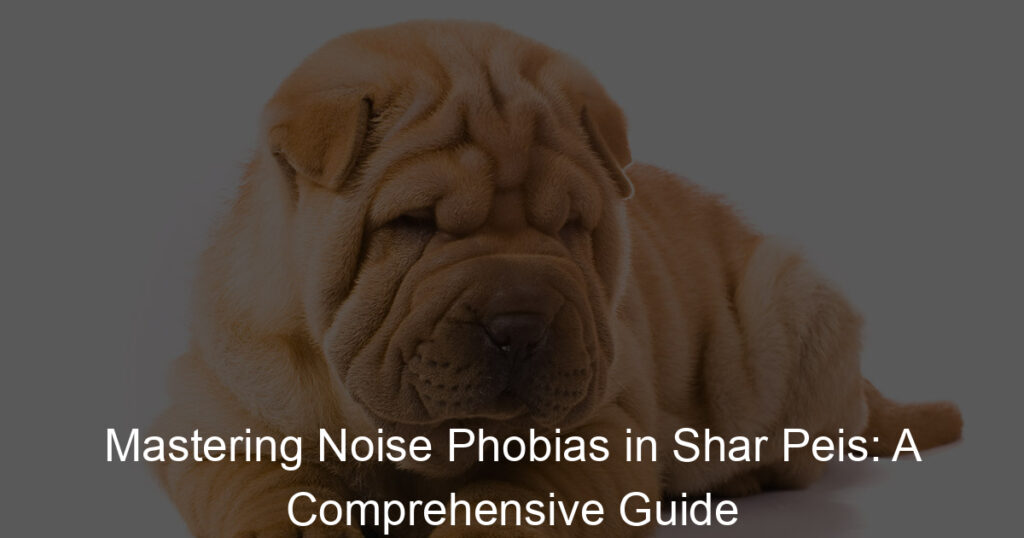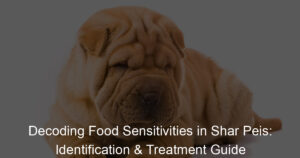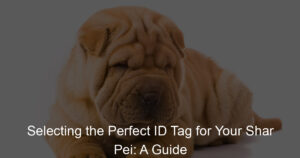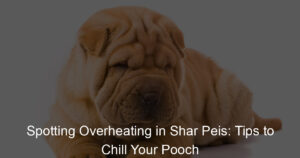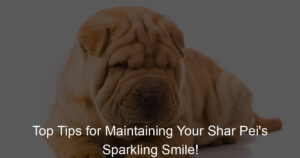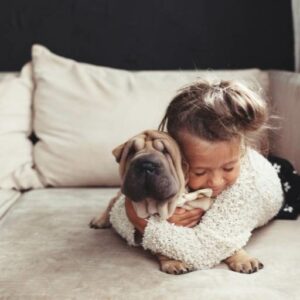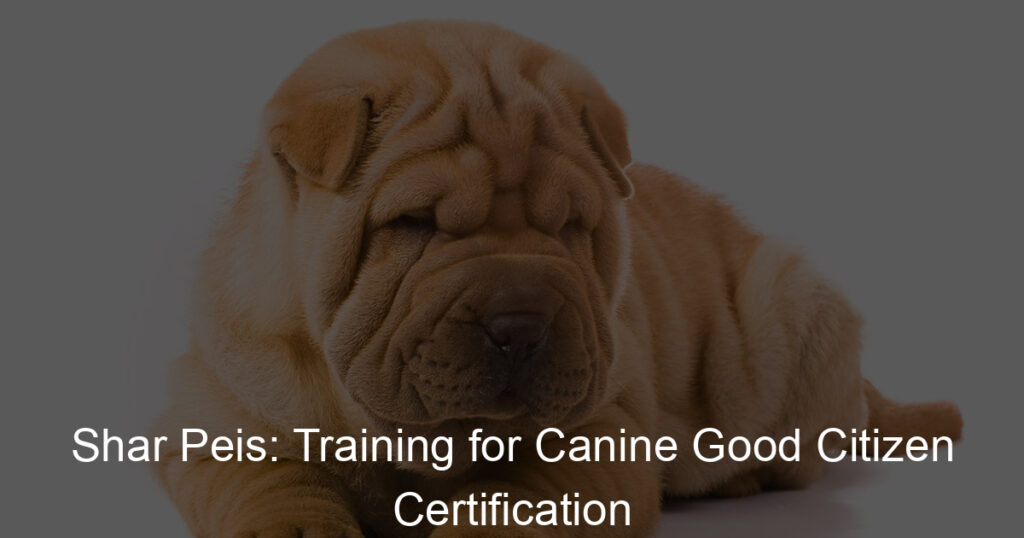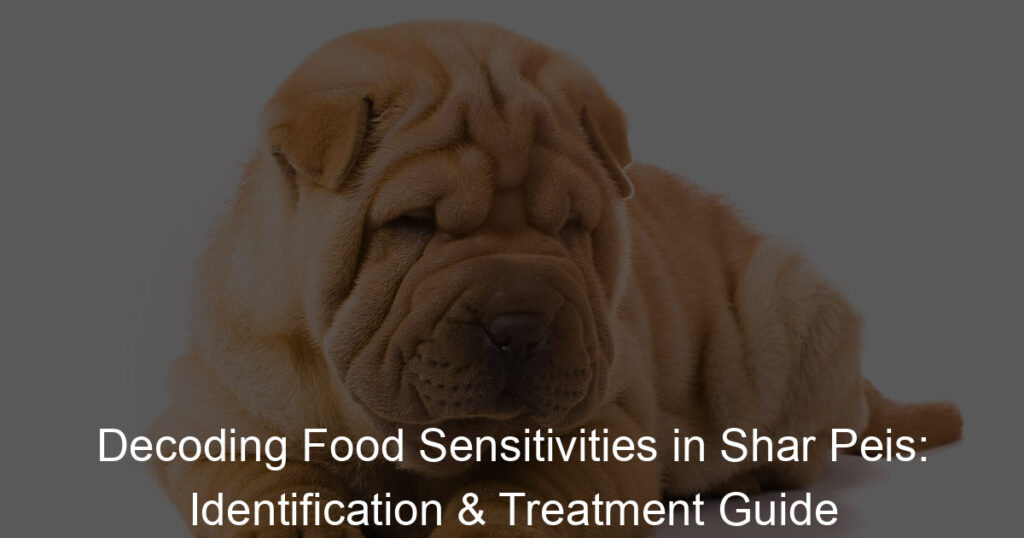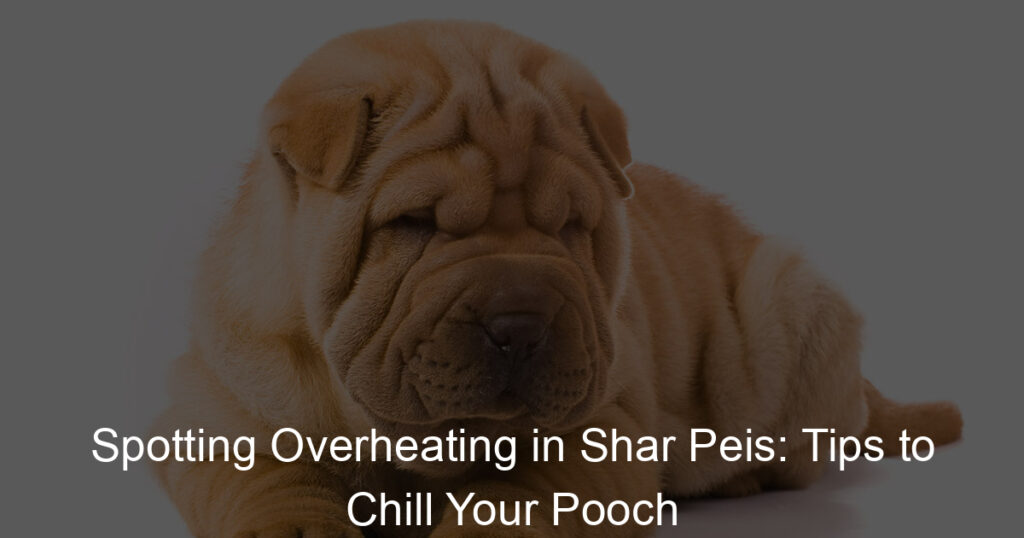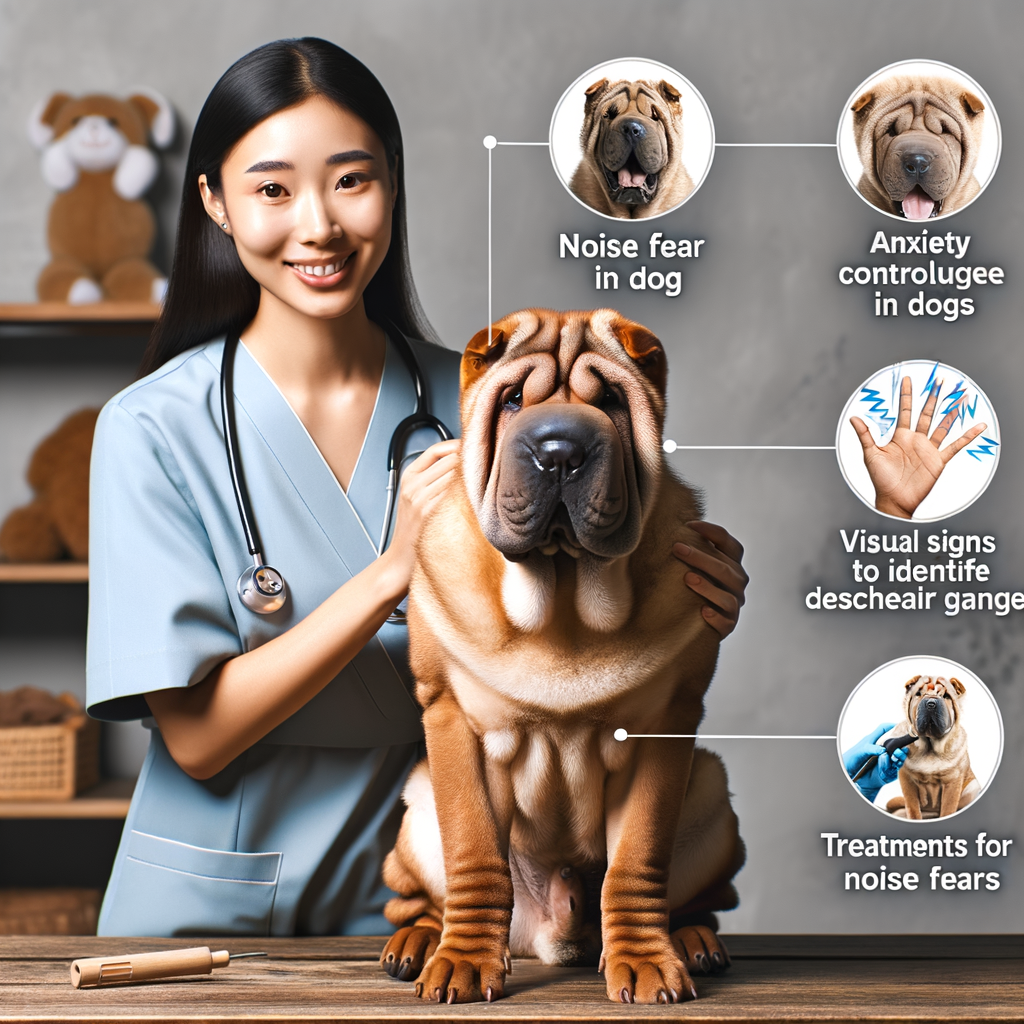
Introduction to Noise Phobia in Dogs
Noise phobia in dogs is a common yet often overlooked issue. It’s a serious condition that can significantly affect a dog’s quality of life. In this section, we will delve into what noise phobia in dogs means and explore some of its common triggers.
- Definition of Noise Phobia in Dogs
- Common Triggers of Noise Phobia in Dogs
- Thunderstorms: The loud booms and crashes of a thunderstorm can be terrifying for a noise-phobic dog.
- Fireworks: The sudden, unexpected bangs and whistles of fireworks are another common trigger.
- Vacuum Cleaners: The loud, persistent noise of a vacuum can also cause fear and anxiety in some dogs.
- Car Alarms: The high-pitched, piercing sound of a car alarm can be another trigger.
Noise phobia in dogs is an excessive and often irrational fear response to specific sounds. It’s more than just a dislike or discomfort; it’s an intense, phobic reaction that can lead to panic and anxiety. Dogs with noise phobia may exhibit behaviors like hiding, shaking, or even trying to escape when they hear the triggering noise.
Various sounds can trigger noise phobia in dogs. Some of the most common include:
It’s important to note that any loud or sudden noise can potentially trigger a noise phobia in a susceptible dog. Each dog is unique, and what triggers one may not affect another.
Understanding noise phobia in dogs is the first step towards helping your furry friend cope with this condition. In the following sections, we will discuss how to recognize noise phobias, specific noise phobia in Shar Pei dogs, managing and treating noise phobias, and how to help your dog cope with this condition.
Recognizing Noise Phobias in Dogs
Recognizing noise phobias in dogs is the first step towards helping your pet cope with this condition. It’s important to understand that dogs express fear and anxiety in different ways, and noise phobia is no exception. Here, we’ll explore the general symptoms of noise phobia in dogs.
General Symptoms of Noise Phobia in Dogs
While every dog may react differently to noise phobias, there are common symptoms that you can look out for. These symptoms can be distressing for both you and your pet, but recognizing them is crucial to managing and treating the phobia.
- Excessive barking or howling: Dogs often express their fear and anxiety through vocalization. If your dog starts barking or howling excessively during a thunderstorm or fireworks, it could be a sign of noise phobia.
- Pacing or restlessness: Another common symptom of noise phobia in dogs is pacing or restlessness. Your dog may seem unable to settle down, constantly moving around the house, especially during loud events.
- Shaking or trembling: Shaking or trembling is a physical response to fear and anxiety. If your dog starts shaking during a thunderstorm or fireworks, it’s likely that they’re experiencing noise phobia.
According to a study, about 50% of dogs with noise phobias exhibit excessive vocalization. This is a clear sign that your dog is uncomfortable and needs your help.
Restlessness in dogs can be a sign of many things, but when paired with a loud noise event, it can indicate noise phobia. It’s a sign that your dog is in distress and is trying to escape the noise.
Shaking can be a distressing symptom to witness, but it’s important to remember that it’s a natural response to fear. Your dog isn’t doing it on purpose; they’re simply reacting to their environment.
Recognizing these symptoms in your dog can help you understand their needs better and take the necessary steps to manage their noise phobia. Remember, every dog is unique, and their reactions to noise can vary. Always consult with a professional if you’re unsure about your dog’s behavior.
Specific Symptoms in Shar Peis
Shar Peis, like other dog breeds, can exhibit unique symptoms when dealing with noise phobia. It’s essential to understand these specific signs to provide the best possible care for your furry friend. Let’s delve into the specific fear responses and behavior issues related to noise phobia in Shar Peis.
- Shar Pei Fear Responses
- Shar Pei Behavior Issues Related to Noise Phobia
Shar Peis may show fear responses that are distinct from other breeds. These can include trying to hide or escape, showing signs of panic, or becoming overly clingy. Some Shar Peis may even show physical symptoms like drooling, panting, or shaking. It’s important to note that these responses are not a sign of bad behavior, but a reaction to an overwhelming fear of loud noises.
Behavior issues in Shar Peis related to noise phobia can manifest in various ways. These can include excessive barking, destructiveness, or even aggression. It’s crucial to understand that these behaviors are not a sign of a ‘bad dog’, but a response to a fear they can’t control. With patience, understanding, and the right approach, these issues can be managed effectively.
Recognizing these specific symptoms in your Shar Pei is the first step towards helping them cope with their noise phobia. Remember, your pet is not acting out, but reacting to a fear they can’t understand. With your help, they can learn to manage their fear and live a happier, healthier life.
Understanding Shar Pei Noise Phobia
Shar Peis, like many other dog breeds, can develop a fear of loud noises. This condition, known as noise phobia, can significantly impact their quality of life. In this section, we will explore why Shar Peis are particularly susceptible to noise phobia and how it can affect their daily lives.
- Why Shar Peis are particularly susceptible to noise phobia
- How noise phobia can affect a Shar Pei’s quality of life
Shar Peis are a unique breed with a distinct personality. They are known for their loyalty, intelligence, and sensitivity. Their heightened sensitivity, however, makes them more prone to developing noise phobias. Loud noises such as thunderstorms, fireworks, or even the sound of a vacuum cleaner can trigger a fear response in these dogs.
Research has shown that Shar Peis have a more developed sense of hearing compared to other breeds. This heightened auditory sensitivity can make them more aware of their surroundings, but it can also make them more susceptible to noise phobia.
Noise phobia can have a profound impact on a Shar Pei’s quality of life. Dogs with this condition may exhibit signs of distress such as panting, trembling, hiding, or attempting to escape. This can lead to self-injury or damage to property.
Moreover, noise phobia can cause long-term stress and anxiety in Shar Peis, leading to behavioral changes. They may become more withdrawn or aggressive, and their eating and sleeping patterns may be disrupted. In severe cases, noise phobia can even lead to health problems such as heart disease and gastrointestinal issues.
In conclusion, understanding noise phobia in Shar Peis is crucial for their well-being. By recognizing the signs and knowing how to manage this condition, owners can help their pets lead a happier and healthier life.
Managing Noise Phobias in Dogs
Managing noise phobias in dogs can be a challenging task. However, with the right strategies, you can help your furry friend overcome their fear. Here are some general strategies you can implement:
General Strategies for Managing Noise Phobias in Dogs
- Creating a safe space
- Using calming techniques
- Implementing desensitization and counter-conditioning
One of the most effective ways to manage noise phobias in dogs is by creating a safe space. This could be a quiet room, a crate, or a corner of your home where your dog feels secure. Make sure this space is always accessible, especially during events that may trigger your dog’s noise phobia, such as thunderstorms or fireworks.
Calming techniques can also be beneficial in managing noise phobias in dogs. This can include gentle petting, speaking in a soothing voice, or even playing soft music. Some pet owners also find that using a weighted blanket or a tight-fitting garment, like a Thundershirt, can help soothe their dog’s anxiety.
Desensitization and counter-conditioning are two techniques that can be used to help dogs overcome their noise phobias. Desensitization involves gradually exposing your dog to the noise that scares them, starting at a low volume and slowly increasing it over time. Counter-conditioning, on the other hand, involves changing your dog’s emotional response to the noise. This can be done by associating the noise with something positive, like a treat or a favorite toy.
Remember, every dog is unique and what works for one might not work for another. It’s important to be patient and persistent, and to consult with a professional if your dog’s noise phobia continues to be a problem.
Specific Strategies for Shar Peis
Shar Peis, known for their distinctive wrinkled skin and blue-black tongue, are a unique breed with specific needs when it comes to managing noise phobias. Here are some strategies tailored specifically for Shar Peis.
-
Shar Pei Anxiety Management Techniques
Shar Peis, like other dogs, can experience anxiety due to noise phobias. It’s important to understand and implement specific anxiety management techniques to help them cope.
Technique Description Creating a Safe Space Designate a quiet, comfortable area in your home where your Shar Pei can retreat during noisy events. This could be a crate, a room with soundproofing, or a spot with their favorite toys and blankets. Calming Techniques Use calming techniques such as gentle petting, soothing voice, or calming music. You can also consider using dog-appeasing pheromones or anxiety wraps. Desensitization and Counter-Conditioning Gradually expose your Shar Pei to the noises that scare them, starting at a low volume and slowly increasing it over time. Pair the noise with something positive, like treats or playtime, to help change their response to the noise. -
Special Considerations for Shar Peis
Shar Peis have some unique characteristics that may affect their response to noise. Here are some special considerations to keep in mind:
- Skin Sensitivity: Shar Peis have sensitive skin due to their wrinkles. When using anxiety wraps or similar products, ensure they are comfortable and not causing irritation.
- Stubborn Nature: Shar Peis can be stubborn, which may make desensitization and counter-conditioning more challenging. Patience and consistency are key in these cases.
- Health Issues: Some Shar Peis may have health issues, such as ear infections, that can make them more sensitive to noise. Regular vet check-ups can help identify and manage these issues.
Treatment for Noise Phobia in Dogs
Noise phobia in dogs is a serious condition that can cause distress and anxiety. It’s important to know when and how to seek help, and what treatments are available. Let’s explore these topics in more detail.
- When to seek professional help
- Medical treatments for noise phobia
- Alternative treatments for noise phobia
If your dog’s noise phobia is causing them significant distress, it may be time to seek professional help. Signs to look out for include excessive barking, shaking, hiding, and destructive behavior during noisy events. If these symptoms persist, it’s best to consult with a veterinarian or a professional dog behaviorist. They can provide a proper diagnosis and suggest a suitable treatment plan.
There are several medical treatments available for noise phobia in dogs. These include anti-anxiety medications, sedatives, and even antidepressants. However, it’s important to remember that these should only be used under the guidance of a veterinarian. Medication can help manage the symptoms, but it’s not a cure. It’s best used in conjunction with behavioral therapy.
Alternative treatments can also be effective in managing noise phobia. These include techniques like desensitization and counter-conditioning. Desensitization involves gradually exposing your dog to the noise that scares them in a controlled way, while counter-conditioning involves changing your dog’s response to the noise. Other alternative treatments include the use of pressure wraps, calming music, and pheromone diffusers. Remember, what works best will depend on your dog’s specific needs.
In conclusion, treating noise phobia in dogs involves recognizing the signs, seeking professional help, and exploring both medical and alternative treatments. With patience and persistence, your dog can learn to cope with their fear of noise, leading to a happier and healthier life.
Coping with Noise Phobia in Shar Peis
Understanding and managing noise phobia in Shar Peis can be a challenging task for pet owners. However, with the right approach and techniques, it’s possible to help your furry friend cope with this condition. Let’s delve into a case study and some key takeaways for Shar Pei owners.
- Case study: Successful management of noise phobia in a Shar Pei
- Key takeaways for Shar Pei owners
- Seek professional help: A certified animal behaviorist can provide the right techniques and strategies to manage noise phobia.
- Be patient and consistent: Overcoming noise phobia doesn’t happen overnight. It requires consistent training and a lot of patience.
- Use positive reinforcement: Reward your Shar Pei for calm behavior during noisy situations. This can help them associate positive experiences with the noise.
- Provide a safe space: During noisy events, make sure your Shar Pei has a quiet, comfortable place to retreat to.
Meet Bella, a three-year-old Shar Pei who had a severe case of noise phobia. The sound of thunderstorms, fireworks, or even a loud car passing by would send her into a panic. Bella’s owners, the Smiths, decided to seek professional help.
With the help of a certified animal behaviorist, they implemented a strategy that included desensitization and counter-conditioning techniques. Bella was gradually exposed to the sounds that scared her in a controlled environment. At the same time, she was rewarded for calm behavior.
After several months of consistent training, Bella’s reaction to noise significantly improved. She no longer panicked at the sound of thunder or fireworks. This case study shows that with patience, consistency, and professional guidance, noise phobia in Shar Peis can be successfully managed.
Based on Bella’s success story, here are some key takeaways for Shar Pei owners dealing with noise phobia:
Remember, every Shar Pei is unique and what works for one may not work for another. It’s important to understand your pet’s specific needs and work with a professional to develop a tailored plan.
Conclusion: Mastering Noise Phobias in Shar Peis
As we reach the end of our discussion on noise phobias in Shar Peis, it’s important to recap the key points and provide some words of encouragement for those dealing with this issue.
- Summary of strategies and treatments
- Encouragement for Shar Pei owners dealing with noise phobia
Throughout this article, we’ve explored a variety of strategies and treatments to help manage and overcome noise phobias in Shar Peis. We’ve learned that early recognition of symptoms is crucial in order to implement effective strategies. We’ve also discovered that understanding the unique characteristics of Shar Peis can help tailor the approach to managing their noise phobia.
Some of the strategies we’ve discussed include creating a safe space for your Shar Pei during noisy events, using noise desensitization techniques, and employing distraction tactics. We’ve also looked at the potential benefits of professional training and the use of calming products. In severe cases, we’ve discussed the option of medication under the guidance of a veterinarian.
Dealing with a Shar Pei who has a noise phobia can be challenging and stressful. However, remember that you are not alone. Many Shar Pei owners have successfully navigated this issue and have seen significant improvements in their dogs’ behavior and quality of life.
It’s important to stay patient and consistent with your strategies. Progress may be slow, but every small step is a victory. Your love and dedication can make a world of difference to your Shar Pei’s wellbeing. Remember, your dog’s trust in you is a powerful tool in overcoming their fear.
In conclusion, mastering noise phobias in Shar Peis is a journey that requires understanding, patience, and persistence. But with the right knowledge and tools, it’s a journey that can lead to a happier, healthier life for your beloved pet.

